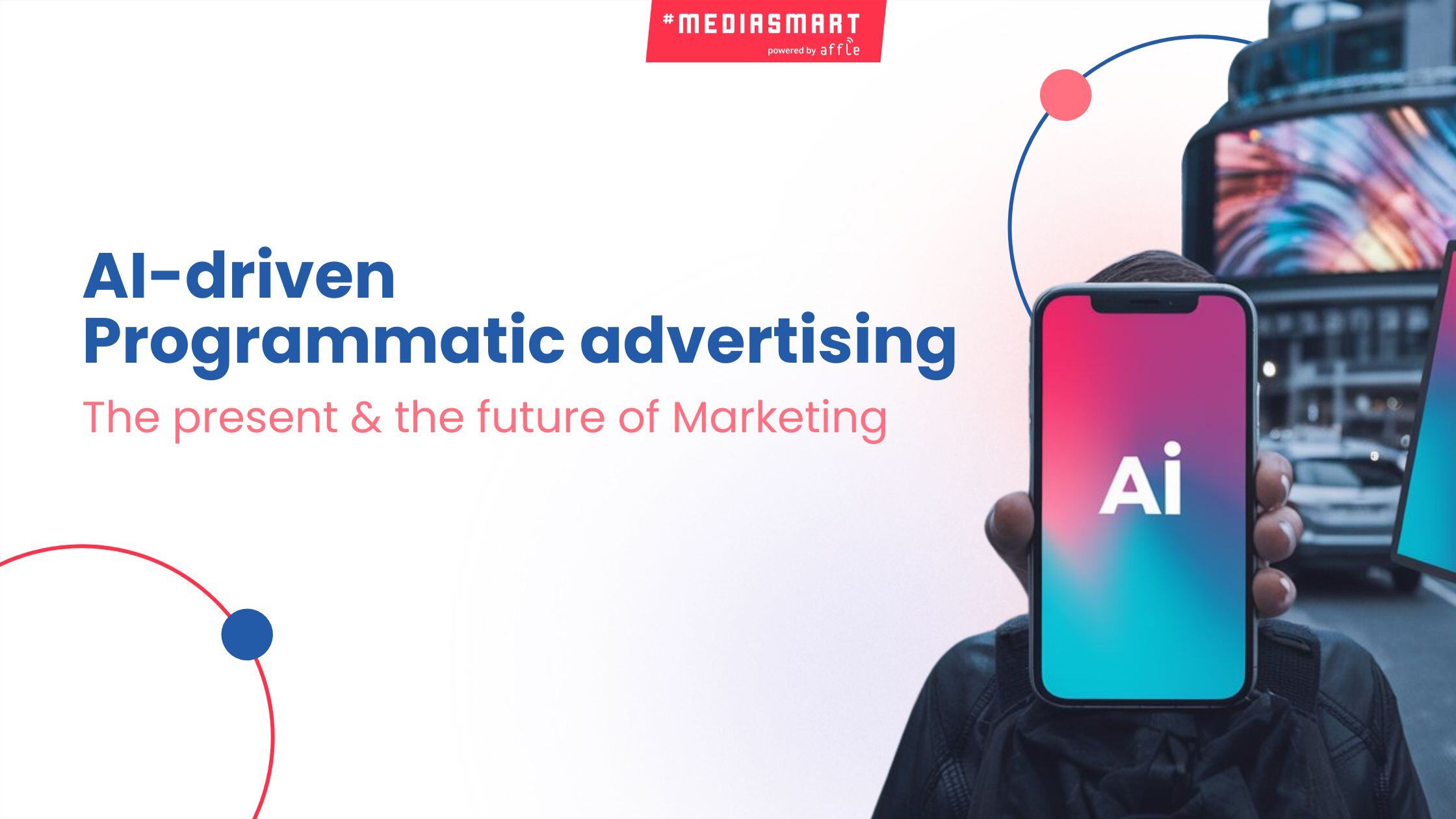Blog
Announcements, analysis and opinions on industry trends around the mobile programmatic world.

Subscribe now, and receive the latest programmatic content directly on your inbox!
Thank you for subscribing to our newsletter
AI-driven Programmatic advertising: the present & the future of Marketing

While much of the current focus on Artificial Intelligence (AI) revolves around Generative AI (GenAI) and Large Language Models (LLMs), it’s essential to understand the broader AI ecosystem and its long-standing impact on the advertising industry. AI, as illustrated in the accompanying graph, spans a spectrum of technologies from Machine Learning (ML) and Neural Networks (NN) to Deep Learning (DL) and GenAI.

Think of AI in programmatic advertising like a smart stock manager in a huge store. Like a great stock manager who knows what products are flying off the shelves and ensures the right items are always available, AI tracks campaign performance to ensure the most relevant ads are delivered. It then automates the process of placing ads where they’re most likely to reach the right audience and engage them, just as a stock manager would pick out the perfect items for you, saving you time and ensuring you see the best offers. But unlike a store manager, AI does this at an astonishing scale, analyzing millions of data points and adjusting strategies in real time.
For over a decade, AI has transformed advertising by automating ad buying, placement, and optimization in real time. Programmatic advertising has emerged as a cornerstone of modern marketing strategies, reflecting its growing significance, the global industry was valued at $546 billion in 2023 and is projected to reach $779 billion by 2026 [1]. AI’s ability to analyze vast amounts of data, predict user behavior, and optimize ad placements has fundamentally reshaped how advertisers engage with consumers. This automation enables brands to reach their target audiences with unparalleled precision and efficiency.
From personalized targeting to efficient campaigns, its impact is profound. Our blog explores the latest AI trends and how they're reshaping the future of marketing. Discover how AI revolutionizing advertising optimization, predictive analytics, fraud prevention, and cross-channel integration.
The role of AI in advertising optimization
Machine learning plays a pivotal role in enhancing the effectiveness of programmatic advertising. These technologies enable automated optimization, predictive modeling, and precise targeting, all of which are essential for maximizing the return on investment (ROI) in advertising campaigns. By utilizing reinforcement learning and advanced algorithms, advertisers can dynamically adjust bids and ad placements in real-time, ensuring that ads reach the most relevant audiences at the right moment.

Imagine you're running an online lemonade stand, and instead of serving everyone the same drink, you adjust the recipe based on what’s selling best over time—extra sweet for some, sour for others. That’s how programmatic optimization works in digital advertising. It analyzes the results of your ad campaigns—like which ads got the most clicks or drove the most downloads, visits, or sales—and then automatically adjusts future bids, and even creatives, to improve the overall performance. It’s all about serving the right ad to the right person at the right time, squeezing the most value out of every impression.
With AI’s foundational role in optimizing advertising strategies established, let’s delve into how predictive analytics and advanced targeting further enhance the precision and effectiveness of these campaigns.
Predictive analytics and advanced targeting
AI’s ability to optimize campaign performance is a game-changer in programmatic advertising, enabling campaigns to be executed at the most optimal times for better results. By predicting key performance indicators like conversions or clicks, AI helps deliver ads when they are most likely to drive meaningful results. This precision targeting not only improves ad relevance but also respects privacy regulations by focusing on campaign-level insights rather than individual tracking. In real-time, AI adjusts strategies based on performance data, refining campaigns for greater efficiency and success.
Moreover, AI excels in creating targeted audience segments by analyzing aggregated user data to identify patterns and shared characteristics. This enables advertisers to focus on high-value segments that reflect similar traits to their best-performing audiences. By grouping users based on behaviors and attributes, AI ensures that ads reach audiences most likely to engage, driving more efficient and effective campaign outcomes. Real-time optimization further strengthens this approach by allowing AI to continuously monitor trends and make adjustments on the fly. This ensures that ads remain relevant and effective even as user behaviors and market conditions shift.
The integration of predictive analytics and advanced targeting not only improves ad relevance but also ensures that advertising budgets are spent efficiently. By minimizing waste and concentrating on high-converting audiences, AI optimizes every dollar spent, leading to more successful and impactful campaigns.
Enhancing efficiency and combatting ad fraud
Efficiency is another area where the use of AI significantly impacts advertising. By automating various aspects of the placement buying process, including bid management, audience segmentation, and creative optimization, AI reduces the manual workload for marketers and enhances the overall efficiency of programmatic campaigns. Resources are allocated optimally, minimizing waste and maximizing cost-effectiveness, contributing to more sustainable advertising practices. When making every dollar count is more critical than ever, maximizing ad efficiency is only half the battle—protecting your investment from fraud is equally crucial, as even the most optimized campaigns can fall victim to wasted spending on fake clicks and impressions.
AI also plays a crucial role in detecting and preventing ad fraud, a persistent challenge in the advertising industry. Ad fraud, which includes activities such as bot clicks, hidden impressions, and ad spoofing, can severely undermine the effectiveness of ad campaigns. AI-driven fraud detection uses advanced algorithms to identify anomalies and fraudulent activities in real time, ensuring data integrity and protecting advertisers’ investments. By mitigating the impact of ad fraud, AI helps maintain the credibility and efficiency of programmatic advertising.
As AI continues to evolve, it lays the groundwork for future innovations, from cross-channel integration to smarter targeting strategies, all designed to elevate programmatic advertising to new heights.
Cross-screen synchronization
Imagine trying to keep up with someone bouncing from their phone to their smart TV to a digital billboard on their commute—yeah, it’s a lot. But AI? It’s like the ultimate multitasker, seamlessly keeping your messaging on point, whether your audience is playing a game on their mobile, binge-watching on CTV, or passing by a DOOH screen. AI ensures that your brand speaks with one voice across all these screens, keeping your campaigns consistent and your strategy tight.
Its ability to manage and optimize cross-screen has become more important than ever, as consumers increasingly engage with brands across multiple devices. 63% of U.S. consumers prefer a mix of online and in-store shopping, with Millennials being the most inclined towards this omnichannel approach[2]. By leveraging machine learning to target audiences, algorithms make real-time decisions to optimize ad placements across screens, ensuring a seamless and cohesive experience across different screens, including Mobile, Connected TV, and Digital Out-Of-Home.

But it’s not just about who sees your ads, it’s about what happens after. AI enhances cross-channel optimization by integrating performance data to empower more precise targeting and a seamless user experience. By pulling in performance data from all these channels, AI enables advertisers to zero in on what works best and fine-tune their targeting. The result? A seamless user experience that feels natural and engaging, rather than disconnected or repetitive. And here’s the kicker: it saves money, maximizing the efficiency of their ad spend across multiple screens is more cost-effective for advertisers.
Roadblocks to maximizing AI’s potential
All that glitters is not gold. One of the biggest hurdles in using AI effectively is the data it feeds on. AI - including GenAI and LLMs - thrives on accurate, high-quality data. But when the data’s scattered, inconsistent, or clouded by privacy restrictions, AI might struggle to deliver. Think of it like asking a top chef to whip up a meal with missing or bad ingredients—it’s just not going to hit the mark. Fragmented data and fuzzy measurement standards mean the decisions AI makes might not be as sharp as they could be, leading to missed targets and wasted spending.
But that’s not all. AI’s algorithms are incredibly complex, often functioning like a black box where the decisions they make are hard to explain. You don’t always know how the AI gets from point A to point B, which can lead to some eyebrow-raising results. These systems, powerful as they are, can unintentionally introduce bias or hallucinations, creating results that just don’t hit the mark. You think you're on the path to optimized campaigns, but hidden in the background, AI might be pushing something off course.
Other roadblocks revolve around trust, legal complexities, and ethical concerns. Trust issues stem from the opaque nature of AI decision-making. According to the IAB, 45% of U.S. advertising market is unsure whether they trust AI systems, highlighting the need for more transparency and regulation[5]. Legal uncertainties, especially around copyright and intellectual property for AI-generated content, pose risks for advertisers using third-party data without permission. Addressing these challenges will require new policies, human oversight, and continued education to ensure safe and effective GenAI use in the industry.
And let’s not forget about how fast everything's moving. GenAI and LLMs are evolving at lightning speed, and consumer behaviors are changing just as fast. Brands are already jumping at the opportunity: Toys'R'us debuted a short promo film, generated primarily using OpenAI's text-to-video tool, at this year's Cannes Lions Festival. Advertisers who don’t keep up with the latest developments risk falling behind. It’s not just about knowing the new tech—it’s about applying it strategically, so your approach stays sharp and relevant. Otherwise, while everyone else is riding the next wave of innovation, you could find yourself stuck in the past, missing out on the next big opportunity.
Pioneering innovations in AI applied to advertising
One of the most promising innovations for Programmatic advertising is the application of Generative AI (GenAI) to enhance and personalize ad creation. Mostly known through given names such as ChatGPT, Gemini, Dall-e, or Midjourney, McKinsey estimates that GenAI could add $2.6 trillion to $4.4 trillion annually to the global economy. Applied to Programmatic ads, GenAI could significantly boost personalized and efficient campaigns, by producing dynamic and personalized ad content that resonates deeply with audiences in a cost-effective way.
GenAI paired with the currently existing Dynamic Creative Optimization (DCO), a technology that automates the testing of ad creatives depending on targeting variables, could be unstoppable. DCO uses behavioral, demographic, and psychographic data to create and refine multiple variations of ad content, A/B testing different strategies to achieve better overall results.
Beyond GenAI, other groundbreaking innovations in AI aim to reshape the advertising landscape. For instance, mediasmart’s AI CTVSafe uses LLMs to ensure Brand safety within the Connected TV space. Our proprietary tool taps on OpenRTB 2.6 CTV content information and LLMs to analyze the environment and discard unsuitable inventory.
As the AI landscape continues to evolve, the advertising industry stands to unlock even more groundbreaking opportunities. Stay tuned; there's much more to come!
The smart wrap-up
AI is at the core of programmatic advertising, driving its evolution and enhancing every facet of its functionality: AI refines optimization, targeting, efficiency, and fraud prevention. The rise of Generative AI has the potential to further revolutionize ad creation, personalization, and real-time optimization, pushing the boundaries of what’s possible in digital marketing.
Statistics reveal that 79% of Gen Z and 80% of Millennials expect personalized shopping experiences based on their previous interactions with brands, both online and in-store[2], and GenAI is estimated to increase Marketing productivity by 5% to 15% of total marketing spending[3]. With the integration of tools like AI CTVSafe and GenAI, the future of programmatic advertising looks exceptionally promising. Advertisers who adopt these innovative technologies will not only achieve greater precision and efficiency but also stay ahead of the competition. Only 38% of businesses in Europe are embedding generative AI in their daily work lives, as reported by IAB Europe and Microsoft[9].
Now is the time to harness these innovations and transform your advertising strategy. At mediasmart, we offer the expertise and technology to help you capitalize on Artificial Intelligence to drive unparalleled results. Don't miss out on the opportunity to elevate your brand's digital presence and effectiveness.
Contact today and join the ranks of leading brands that trust mediasmart to drive their digital advertising success.
Sources
[1] Global programmatic ad spend 2028 | Statista
[2] Dentsu Consumer Navigator: Retail & Commerce 2023
[3] The economic potential of generative AI | McKinsey
[4] Dentsu Consumer Navigator: Generative AI 2024
[5] Legal issues and business considerations when using GenAI in Digital Advertising | IAB
[6] 24 data-backed Reasons to personalize your marketing | Hubspot
[7] A personalized experience for customers: Driving differentiation in retail | McKinsey
[8] Great debate on AI in Digital Advertising | IAB Europe
[9] Understanding the adoption and application of AI in Digital Advertising | IAB & Microsoft
Topics: data, programmatic, AI, ctv advertising, AI-powered targeting, AI in programmatic, Personalization, Generative AI, GenAI

